Matthew Houde's Blog, page 37
June 18, 2014
The Pure Life Pace: A Horseback Tour in Nosara

We started our morning at the Boca, the mouth of the river where the Rio Nosara and the Rio Montana converge and spill into the Pacific. Our guide was Manuel, a Tico who has been caring for the horses at Boca Nosara Tours for over ten years. Matt and I were both horseback-riding amateurs, having done it only once before, but Manuel and the team put us at ease, giving us instructions and making sure we were comfortable handling our horses before we left.
Atop our beautiful horses, Palomo and Zafiro, we first headed into the nature reserve not far from the property. Thick mangroves filled the wetlands beside the trail. Howler monkeys groaned from high up in the canopy. Colorful birds like Motmots, Violaceous Trogans, and Long-tailed Manakins darted past. Manuel taught us all about the wildlife and some of the native trees too, like the grand Guanacaste tree, which drops pods with beautiful brown seeds. We passed a point on the river which was said to often have crocodiles but didn’t spot any.
A dirt road led us back into the thick jungle, this time closer to the beach. The rainy season had just begun and the plants were turning from dry and brown to vibrant green. The horses, used to eating hay, were grabbing for the tender greens like a kid grabs for candy. We continued on, Manuel blazing through the jungle with his machete, cutting back any overgrown plants that might be in our way.
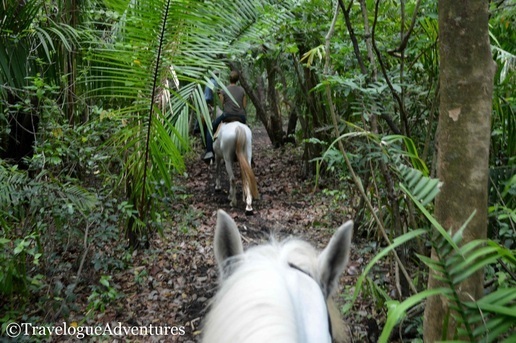
Soon we were on the beach. Playa Pelada was all but deserted. It was a calm day and the ocean was a picturesque aquamarine. We passed by the famous blowhole on the rocks just as a wave came thundering in, a little girl and her parents getting sprayed by the mist. As we started rounding the corner, Manuel asked if we would like to gallop. We said we would and the horses were off, bounding through the fluffy white sand.
We soon entered the jungle again and climbed the hill to a lookout. In front of us was a stunning view of the cove below. Just when we thought Costa Rica couldn’t amaze us anymore with its natural beauty, it proved us wrong once again.

Horseback riding was of our favorite activities while living in Nosara. The ride was relaxing and exciting at the same time, and we were able to see so much in just a couple of hours. There are lots of tour companies in the area but we loved our ride with Boca Nosara Tours.
So if you’re looking to take a break from the heart-pumping activities that Costa Rica is famous for, be sure to add a horseback tour to your list. Whether it’s in Nosara or one of the many other towns offering tours, we’re sure you’ll love the laid-back pace, connection with nature, and most of all, chance to experience la pura vida.
You Might Also Like:
Tamarindo: Where Paradise Meets Convenience
Costa Rica: Your 2-Week Itinerary
Diria National Park: Hiking Near Guanacaste's Gold Coast
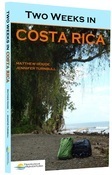
To learn more about Costa Rica, check out our book, Two Weeks in Costa Rica. It's a travelogue with a guidebook twist.
Read reviews and excerpts on Amazon.
Post by: Jennifer Turnbull-Houde & Matthew Houde
June 13, 2014
The Cost of Owning a Car in Costa Rica
Since Buying a Car in Costa Rica about 10 months ago, we have gone through many of the motions of car ownership, including taxes, insurance, maintenance, and of course repairs. Anyone living in Costa Rica will tell you that the roads are rough and your car will take a toll. Our 14-year old Chevy Tracker has had an especially difficult past several months. Since we bought it, we’ve been vagabonding around the country and have put on 15,000 miles. From the southern Pacific to the Caribbean coast, to northern Guanacaste and the mountains of the Central Valley, we’ve been on smooth highways, sandy beach trails, as well as some of the worst pothole-ridden roads in the country. With that much travel, we feel lucky to still have four wheels on the ground, let alone a functioning car. This post will cover some of the regular maintenance costs anyone would encounter as well as specific issues we’ve faced since owning the Green Buggy.
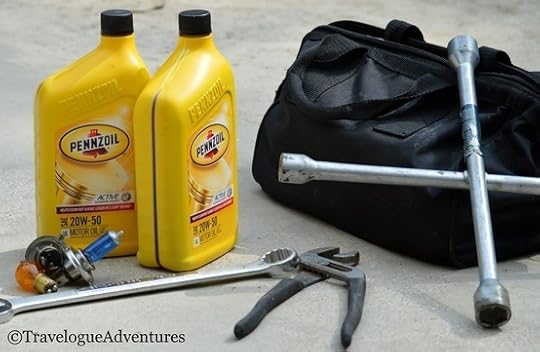
General Ownership & Routine Maintenance ($630 plus gas)
Annual Marchamo (registration & mandatory liability insurance): Marchamo is easily renewed at many banks in Costa Rica. Our cost: $230 (based on vehicle year, make, and model). Newer or high-end cars will be more. Marchamo is due at the end of the year (payable Nov. – Dec.).
Annual Riteve (vehicle inspection): We had heard horror stories about people needing many repairs to get their Riteve and were even warned when buying a car to make sure the Riteve was not about to expire. The general consensus after talking to a few people was to have a mechanic bring it in for you, so that’s what we did. We dropped off the car with a mechanic for a few days while he did some repairs, and waited for his phone call. Cost: $18 for actual Riteve + $20 service fee + cost of repairs (steering column, rear brakes, muffler welding; see costs below). The peace of mind of having the mechanic take care of it was worth every penny of the $20 fee.
Additional Insurance Coverage (purchased through INS, the national insurance company in CR): This of course is optional but we paid about $130 for an annual policy with a good amount of extra liability (no collision) coverage. Find a local agent to see what works for you.
Gas: Gas prices have been consistently above the $5 per gallon mark ($1.30+ per liter) for our time here. This makes the cost to fill our modest 17 gallon (64 liter) tank a wallet-hurting $80-90. Diesel is a little cheaper at about $4.75 per gallon ($1.25 per liter). The good news is that the price is the same at all gas stations because it’s government regulated so you don’t have to bother shopping around.
Oil Changes: Similar to gas, oil is expensive. At $8-10 per quart, an oil change done by a mechanic can run around $70 (5 quarts oil + filter); depending on where you live and what kind of car you have, it could be a little more or a little less. We’ve started buying the oil and doing it ourselves instead for about $50.
Air for Tires: One nice thing about Costa Rica is that you never pay for air. Pull into any gas station and the attendant will gladly check your pressure, even if you don’t buy gas.
Headlight or Blinker Bulbs: Also very easy, most of the larger gas stations have an inventory of the popular bulbs and other things like wipers, fluids, etc. They will also usually install them for free. Cost $6-12.
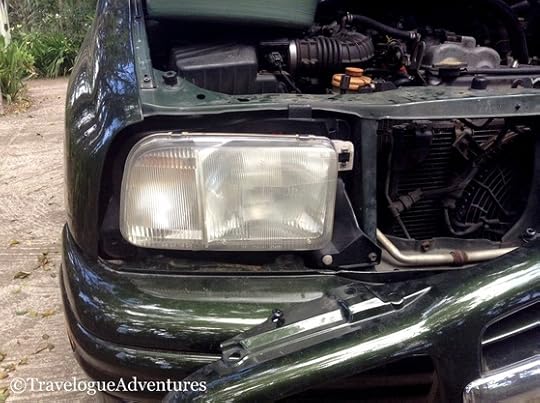
Spiffy new headlight assembly
Unexpected Repairs (Total ~ $725)
Serpentine Belt & Pulley: Unfortunately our belt went during the week between Christmas and New Year’s. If it had been just the belt, we would have been fine, but since all the parts’ stores were closed for the holidays (and then were backed up afterwards), we waited 10 days for the pulley to arrive. Total cost: $310. The lesson: If your car breaks down during one of the big holidays in Costa Rica like Christmas or Easter, don’t expect to see it anytime soon.
New Headlight & Assembly: The hot weather had dry-rotted the plastic fasteners holding in our headlight. We didn’t even want to try getting this from the parts’ store so we bought it on eBay for $40 and had some friends bring it down, then installed it ourselves.
New Battery: One thing about bumpy roads and hot conditions is that they can really take a toll on your battery. When ours died, we decided on a quality new one with a 2-year warranty. Cost: $120.
Tire Patch: We got tired of visiting the gas station every three days to add air and finally got it patched up for just $3. Look around and you will see dozens of tire repair shops along the road (Reparar de llantas).
New Steering Column: This was part of our necessary Riteve inspection repairs. The new one is actually a used part and doesn’t look much better than the old. Cost: $150 (parts & installation).
Rear Brake Pads: Also part of the inspection, but we thought we might need brakes anyway as they were starting to squeak. Cost: $50 (parts & installation).
Muffler Welding: It’s no wonder that most people who live in Nosara (where we’ve been living for the last couple months) have an ATV or a horse to get around. Many of the roads along the central and southern Nicoya Peninsula are basically like off-road trails, especially in the rainy season. Our muffler shook loose after hitting a few massive potholes just in time for inspection. Cost: $46.
Bolt installation (missing from steering column installation): The mechanic must have forgotten to install a cotter pin on the tie-rod end because we lost a bolt a few days after we picked it up. Fortunately the nearby gas station mechanic had a jar full of them and we were back on the road $6 later.

“Road” south of Nosara. Note the SUV stuck in the mud. Luckily it wasn’t us.
Overall, around $725 in unexpected repairs is probably less than we imagined over a ten month period for such an old car. We knew going into it that buying a used car in Costa Rica was a gamble and we would probably need to make some major repairs. Through all of our car woes, it has helped that Matt is mechanically inclined. For example, when our muffler became unattached about an hour and a half from home, he MacGyvered some coiled up barbed wire from a nearby fence to temporarily hold it in position and prevent any more damage. Similarly, after the shop installed our new battery, we discovered that it was really loose and bouncing around. The missing steering column bolt is another good example of a careless installation. Last but not least, after our first oil change, we noticed that the filter that the mechanic used was about half the size that it should have been (it looked like a motorcycle filter). By far the best thing we brought to Costa Rica was a bag full of tools and some backyard mechanic knowledge; it has saved us far more than the extra baggage fee we paid. Now to find out what that loud noise is coming from the front end . . . .
All in all, we don’t regret buying a car as it has given us the freedom to see so many parts of this amazing country. Maybe at some point though we’ll be able to upgrade to something a little newer, maybe even from this decade.
Post by: Matthew Houde and Jennifer Turnbull-Houde
June 12, 2014
The Cost of Owning a Car in Costa Rica

General Ownership & Routine Maintenance ($630 plus gas)
Annual Marchamo (registration & mandatory liability insurance): Marchamo is easily renewed at many banks in Costa Rica. Our cost: $230 (based on vehicle year, make, and model). Newer or high-end cars will be more. Marchamo is due at the end of the year (payable Nov. - Dec.).
Annual Riteve (vehicle inspection): We had heard horror stories about people needing many repairs to get their Riteve and were even warned when buying a car to make sure the Riteve was not about to expire. The general consensus after talking to a few people was to have a mechanic bring it in for you, so that’s what we did. We dropped off the car with a mechanic for a few days while he did some repairs, and waited for his phone call. Cost: $18 for actual Riteve + $20 service fee + cost of repairs (steering column, rear brakes, muffler welding; see costs below). The peace of mind of having the mechanic take care of it was worth every penny of the $20 fee.
Additional Insurance Coverage (purchased through INS, the national insurance company in CR): This of course is optional but we paid about $130 for an annual policy with a good amount of extra liability (no collision) coverage. Find a local agent to see what works for you.
Gas: Gas prices have been consistently above the $5 per gallon mark ($1.30+ per liter) for our time here. This makes the cost to fill our modest 17 gallon (64 liter) tank a wallet-hurting $80-90. Diesel is a little cheaper at about $4.75 per gallon ($1.25 per liter). The good news is that the price is the same at all gas stations because it’s government regulated so you don’t have to bother shopping around.
Oil Changes: Similar to gas, oil is expensive. At $8-10 per quart, an oil change done by a mechanic can run around $70 (5 quarts oil + filter); depending on where you live and what kind of car you have, it could be a little more or a little less. We’ve started buying the oil and doing it ourselves instead for about $50.
Air for Tires: One nice thing about Costa Rica is that you never pay for air. Pull into any gas station and the attendant will gladly check your pressure, even if you don’t buy gas.
Headlight or Blinker Bulbs: Also very easy, most of the larger gas stations have an inventory of the popular bulbs and other things like wipers, fluids, etc. They will also usually install them for free. Cost $6-12.
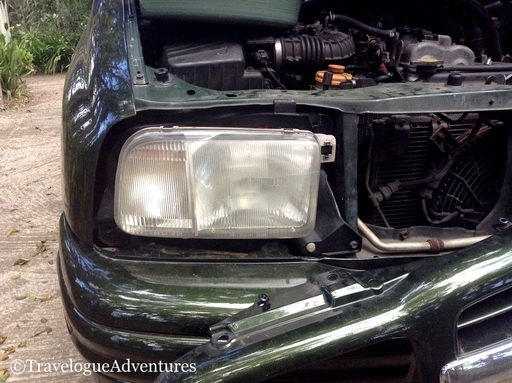 Spiffy new headlight assembly
Spiffy new headlight assembly Unexpected Repairs (Total ~ $725) Serpentine Belt & Pulley: Unfortunately our belt went during the week between Christmas and New Year’s. If it had been just the belt, we would have been fine, but since all the parts’ stores were closed for the holidays (and then were backed up afterwards), we waited 10 days for the pulley to arrive. Total cost: $310. The lesson: If your car breaks down during one of the big holidays in Costa Rica like Christmas or Easter, don’t expect to see it anytime soon.
New Headlight & Assembly: The hot weather had dry-rotted the plastic fasteners holding in our headlight. We didn’t even want to try getting this from the parts’ store so we bought it on eBay for $40 and had some friends bring it down, then installed it ourselves.
New Battery: One thing about bumpy roads and hot conditions is that they can really take a toll on your battery. When ours died, we decided on a quality new one with a 2-year warranty. Cost: $120.
Tire Patch: We got tired of visiting the gas station every three days to add air and finally got it patched up for just $3. Look around and you will see dozens of tire repair shops along the road (Reparar de llantas).
New Steering Column: This was part of our necessary Riteve inspection repairs. The new one is actually a used part and doesn’t look much better than the old. Cost: $150 (parts & installation).
Rear Brake Pads: Also part of the inspection, but we thought we might need brakes anyway as they were starting to squeak. Cost: $50 (parts & installation).
Muffler Welding: It’s no wonder that most people who live in Nosara (where we’ve been living for the last couple months) have an ATV or a horse to get around. Many of the roads along the central and southern Nicoya Peninsula are basically like off-road trails, especially in the rainy season. Our muffler shook loose after hitting a few massive potholes just in time for inspection. Cost: $46.
Bolt installation (missing from steering column installation): The mechanic must have forgotten to install a cotter pin on the tie-rod end because we lost a bolt a few days after we picked it up. Fortunately the nearby gas station mechanic had a jar full of them and we were back on the road $6 later.
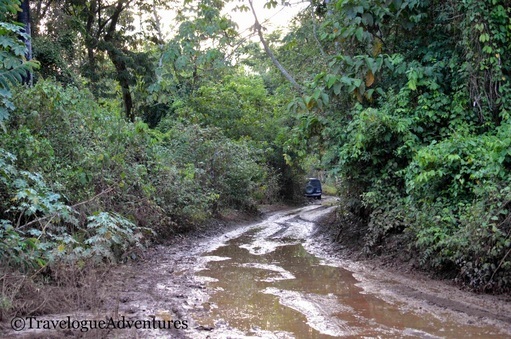 "Road" south of Nosara. Note the SUV stuck in the mud. Luckily it wasn't us.
"Road" south of Nosara. Note the SUV stuck in the mud. Luckily it wasn't us. Overall, around $725 in unexpected repairs is probably less than we imagined over a ten month period for such an old car. We knew going into it that buying a used car in Costa Rica was a gamble and we would probably need to make some major repairs. Through all of our car woes, it has helped that Matt is mechanically inclined. For example, when our muffler became unattached about an hour and a half from home, he MacGyvered some coiled up barbed wire from a nearby fence to temporarily hold it in position and prevent any more damage. Similarly, after the shop installed our new battery, we discovered that it was really loose and bouncing around. The missing steering column bolt is another good example of a careless installation. Last but not least, after our first oil change, we noticed that the filter that the mechanic used was about half the size that it should have been (it looked like a motorcycle filter). By far the best thing we brought to Costa Rica was a bag full of tools and some backyard mechanic knowledge; it has saved us far more than the extra baggage fee we paid. Now to find out what that loud noise is coming from the front end…
All in all, we don’t regret buying a car as it has given us the freedom to see so many parts of this amazing country. Maybe at some point though we’ll be able to upgrade to something a little newer, maybe even from this decade.
You Might Also Like:
Buying a Car in Costa Rica
Packing for Your Move to Costa Rica: Advice from Expats
Humidity and Your Camera: Making a Dry Box in the Tropics
WE'RE MOVING TO COSTA RICA!
 Jennifer Turnbull and Matthew Houde first visited Costa Rica about ten years ago. They fell in love with the country’s friendly culture and natural beauty and returned for vacation year after year. In 2012, they published a book about their travels,
Two Weeks in Costa Rica
. Most recently, they took the ultimate plunge and left their careers in the United States for a chance to experience the pura vida lifestyle. They now write full-time from Costa Rica. Follow their adventures on their blog or via Twitter and Facebook. Post by: Matthew Houde and Jennifer Turnbull-Houde
Jennifer Turnbull and Matthew Houde first visited Costa Rica about ten years ago. They fell in love with the country’s friendly culture and natural beauty and returned for vacation year after year. In 2012, they published a book about their travels,
Two Weeks in Costa Rica
. Most recently, they took the ultimate plunge and left their careers in the United States for a chance to experience the pura vida lifestyle. They now write full-time from Costa Rica. Follow their adventures on their blog or via Twitter and Facebook. Post by: Matthew Houde and Jennifer Turnbull-Houde
June 4, 2014
How to Save on Travel in Costa Rica
Although Costa Rica is less expensive than many destinations in North America, Europe, and the South Pacific, it isn’t as budget friendly today as it once was. Like all great things, the word has gotten out about Costa Rica’s awesomeness. Its beautiful beaches, rainforests, and wildlife draw millions of visitors annually, and with that popularity, prices are on the rise. But don’t fret. If you’re a frugal traveler, there are plenty of ways to save. Here are our top 10 tips for saving money on your trip to Costa Rica.
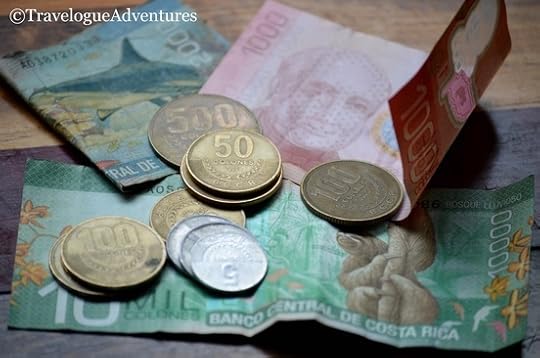
Costa Rican Colones
1. Travel during the low season
Most people visit Costa Rica during the dry season, but if you don’t mind getting a little wet, the rainy season is a great time to come. Everything is green and lush and beautiful. The rainy season runs from May to November but in most locations it doesn’t get too intense until August. Hotels are a lot cheaper and it’s much easier to negotiate discounts on tours and activities when there are fewer tourists around.
2. Don’t travel during the holiday season
Christmas is a big holiday in Costa Rica and is the busiest time of year for travel. Most hotels charge peak rates during the weeks leading up to and following the holiday. It’s not just hotels either. Other things are more expensive too, like rental cars.
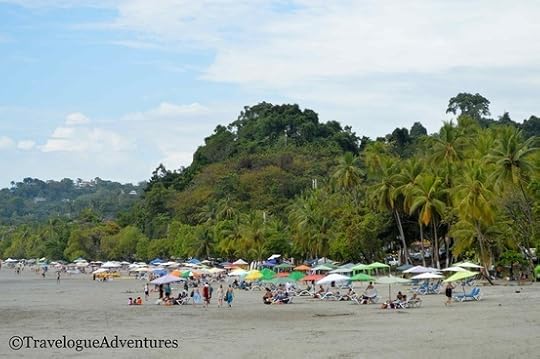
A busy Manuel Antonio beach during the holidays
3. Avoid big tourist towns
The most popular destinations, like the beach towns of Guanacaste, are more expensive than lesser known places that haven’t made it into the guidebook yet. Of course you’ll want to visit the hotspots too, but staying just 15 minutes away could save you for a lot on meals and lodging.
4. Make sure you need a tour
You can visit a lot of places (e.g., national parks, waterfalls) on your own if you’re trying to save money. Guides definitely add value to nature tours because of their expertise but you probably don’t need to have every tour be a guided one.
5. Think twice about renting a 4WD
Do some research before deciding whether to rent a standard sedan or a more expensive SUV/truck with four-wheel drive. Although there are places in Costa Rica where you definitely want 4WD, you don’t need it everywhere.
6. Eat at sodas
Sodas are mom and pop restaurants that serve inexpensive, typical Costa Rican food. They vary in size from full-blown restaurants to shacks with a couple of stools. Often they don’t look like much but don’t let the plastic tablecloths and simple structures stop you. We’ve had some of our best meals at the most unassuming places.
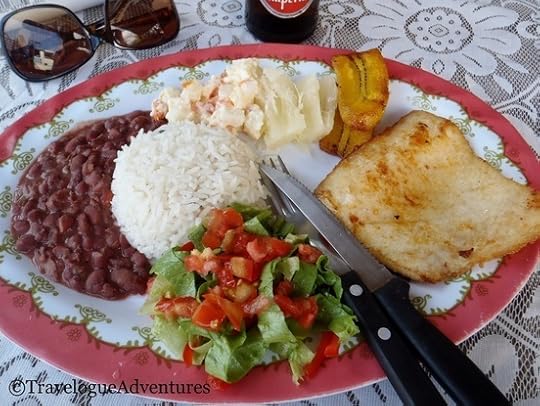
Casados are traditional lunch dishes found at sodas and very inexpensive at around $6
7. Take the public bus
Ride with the locals on the public bus. It’s certainly not the fastest or most convenient option but it’s cheap and can get you almost anywhere you need to go. Plus it’s a great cultural experience.
8. Look into vacation rentals
This applies to other countries of course too but we’ve saved a lot by using sites like Airbnb. Costa Rica has tons of vacation rental listings from studios to shared rooms to whole houses, many of which are a lot cheaper (and often nicer) than standard hotels. As a bonus, maybe you’ll have a kitchenette so that you can have some meals in.
9. Skip the bottled water
There are exceptions depending on where you’re visiting (e.g., Puerto Viejo), but almost everywhere in Costa Rica the water is treated and safe to drink.
10. Take advantage of free/inexpensive activities
Sure you’ll want to go zip-lining and do other fun tours, but Costa Rica has lots to do for free or not very much. Get a sense of the culture by walking around a Tico town, browse the local feria (farmer’s market), or visit one of the 50+ national parks and reserves.
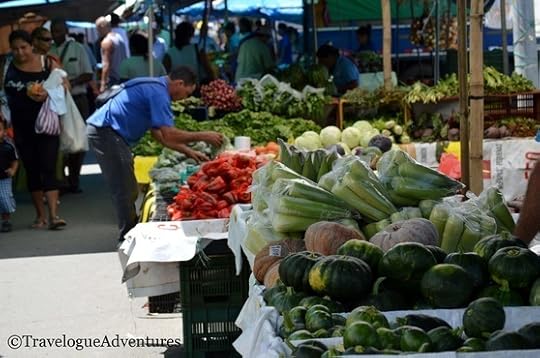
Quepos feria
Costa Rica is one of the most expensive places to visit in Central America but there are plenty of ways to keep those colones in your pocket. It’s easy to save money and still see (almost) everything that this amazing country has to offer.
What do you do to save money when you travel?
Post by: Jennifer Turnbull-Houde & Matthew Houde
June 3, 2014
How to Save on Travel in Costa Rica
 Costa Rican Colones 1. Travel during the low season
Costa Rican Colones 1. Travel during the low seasonMost people visit Costa Rica during the dry season, but if you don’t mind getting a little wet, the rainy season is a great time to come. Everything is green and lush and beautiful. The rainy season runs from May to November but in most locations it doesn’t get too intense until August. Hotels are a lot cheaper and it’s much easier to negotiate discounts on tours and activities when there are fewer tourists around.
2. Don’t travel during the holiday season
Christmas is a big holiday in Costa Rica and is the busiest time of year for travel. Most hotels charge peak rates during the weeks leading up to and following the holiday. It’s not just hotels either. Other things are more expensive too, like rental cars.
 A busy Manuel Antonio beach during the holidays
A busy Manuel Antonio beach during the holidays 3. Avoid big tourist towns
The most popular destinations, like the beach towns of Guanacaste, are more expensive than lesser known places that haven’t made it into the guidebook yet. Of course you’ll want to visit the hotspots too, but staying just 15 minutes away could save you for a lot on meals and lodging.
4. Make sure you need a tour
You can visit a lot of places (e.g., national parks, waterfalls) on your own if you’re trying to save money. Guides definitely add value to nature tours because of their expertise but you probably don’t need to have every tour be a guided one.
5. Think twice about renting a 4WD
Do some research before deciding whether to rent a standard sedan or a more expensive SUV/truck with four-wheel drive. Although there are places in Costa Rica where you definitely want 4WD, you don’t need it everywhere.
6. Eat at sodas
Sodas are mom and pop restaurants that serve inexpensive, typical Costa Rican food. They vary in size from full-blown restaurants to shacks with a couple of stools. Often they don’t look like much but don’t let the plastic tablecloths and simple structures stop you. We’ve had some of our best meals at the most unassuming places.
 Casados are traditional lunch dishes found at sodas and very inexpensive at around $6
Casados are traditional lunch dishes found at sodas and very inexpensive at around $6 7. Take the public bus
Ride with the locals on the public bus. It’s certainly not the fastest or most convenient option but it’s cheap and can get you almost anywhere you need to go. Plus it’s a great cultural experience.
8. Look into vacation rentals
This applies to other countries of course too but we’ve saved a lot by using sites like Airbnb. Costa Rica has tons of vacation rental listings from studios to shared rooms to whole houses, many of which are a lot cheaper (and often nicer) than standard hotels. As a bonus, maybe you’ll have a kitchenette so that you can have some meals in.
9. Skip the bottled water
There are exceptions depending on where you’re visiting (e.g., Puerto Viejo), but almost everywhere in Costa Rica the water is treated and safe to drink.
10. Take advantage of free/inexpensive activities
Sure you’ll want to go zip-lining and do other fun tours, but Costa Rica has lots to do for free or not very much. Get a sense of the culture by walking around a Tico town, browse the local feria (farmer’s market), or visit one of the 50+ national parks and reserves.
 Quepos feria
Quepos feria Costa Rica is one of the most expensive places to visit in Central America but there are plenty of ways to keep those colones in your pocket. It’s easy to save money and still see (almost) everything that this amazing country has to offer. What do you do to save money when you travel?
You Might Also Like:
Costa Rica: Your 2-Week Itinerary
The Costa Ballena: Uvita, Dominical, and Ojochal
Hiking in Arenal National Park

To learn more about Costa Rica, check out our book, Two Weeks in Costa Rica. It's a travelogue with a guidebook twist.
Read reviews and excerpts on Amazon. Post by: Jennifer Turnbull-Houde & Matthew Houde
May 29, 2014
Hog Heaven at Playa Avellanas
When we recently lived in Playa Grande just north of Tamarindo in Costa Rica’s Guanacaste region, we drove down the coast to check out some of the lesser known beaches. One of our favorites was Playa Avellanas. Not only is Playa Avellanas a beautiful beach, but there’s also a great beach bar (with a resident pig) that is the perfect place to relax the day away with a frosty Imperial.
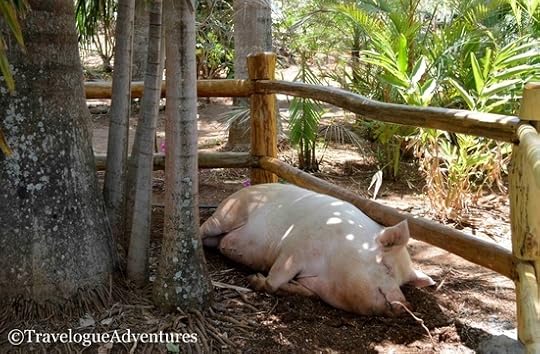
Lola the pig taking an afternoon siesta
Although Playa Avellanas is close to Tamarindo, it still takes about 20-30 minutes to get there because the road turns to dirt after the town of Villa Real. The drive itself though is all part of the experience. On the way, you pass through small Tico towns and can really get a sense of what life is like outside of the big tourism destinations. Tip: Map out your route in advance. There aren’t too many turns but signage is not the best!
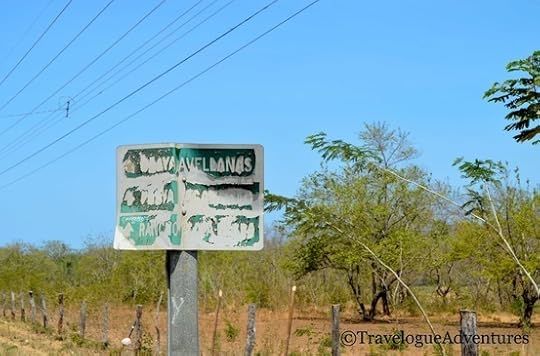
At Playa Avellanas, you’ll enjoy beautiful light sand and rolling turquoise waves. The beach doesn’t see the same crowds as Tamarindo, so there’s always a place to put down a towel. Surfing is one of the most popular activities, and the beach has breaks for both experts and beginners. If you’re looking to take a lesson, there are plenty of schools in the small town to choose from.
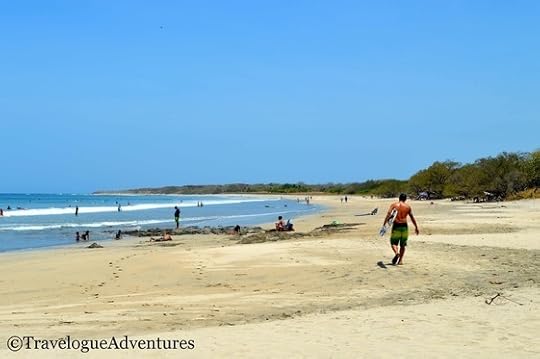
The beach itself is spectacular but what makes the trip worth it is Lola’s, the restaurant just steps from the shore. The grounds of Lola’s are stunning, with grand shady palm trees and handcrafted wooden tables and lounge chairs. Lola’s mixes up some delicious cocktails and has excellent, no-nonsense food with an emphasis on natural ingredients. Though not a budget option, Lola’s has an array of choices including some dishes that can be hard to find in Costa Rica like homemade veggie burgers and falafel. But the best part, aside from the ocean view of course, is the giant pig that lives on the property.
So, if you’re visiting Tamarindo and want to do some exploring, grab your beach hat and head down the coast to Playa Avellanas. Chill out on the sand, jump in the warm Pacific, and don’t forget to grab a cerveza and some ceviche with Lola!
Post by: Jennifer Turnbull-Houde & Matthew Houde
May 28, 2014
Hog Heaven at Playa Avellanas
 Lola the pig taking an afternoon siesta
Lola the pig taking an afternoon siesta Although Playa Avellanas is close to Tamarindo, it still takes about 20-30 minutes to get there because the road turns to dirt after the town of Villa Real. The drive itself though is all part of the experience. On the way, you pass through small Tico towns and can really get a sense of what life is like outside of the big tourism destinations. Tip: Map out your route in advance. There aren’t too many turns but signage is not the best!
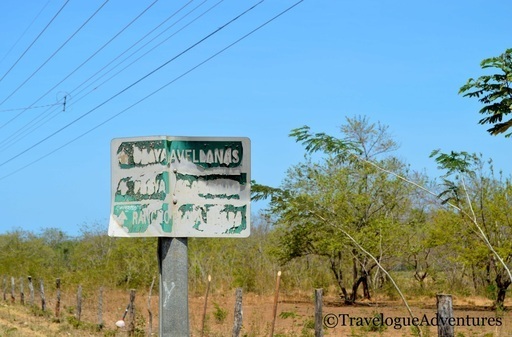
At Playa Avellanas, you’ll enjoy beautiful light sand and rolling turquoise waves. The beach doesn’t see the same crowds as Tamarindo, so there’s always a place to put down a towel. Surfing is one of the most popular activities, and the beach has breaks for both experts and beginners. If you’re looking to take a lesson, there are plenty of schools in the small town to choose from.

The beach itself is spectacular but what makes the trip worth it is Lola’s , the restaurant just steps from the shore. The grounds of Lola’s are stunning, with grand shady palm trees and handcrafted wooden tables and lounge chairs. Lola’s mixes up some delicious cocktails and has excellent, no-nonsense food with an emphasis on natural ingredients. Though not a budget option, Lola’s has an array of choices including some dishes that can be hard to find in Costa Rica like homemade veggie burgers and falafel. But the best part, aside from the ocean view of course, is the giant pig that lives on the property.
So, if you’re visiting Tamarindo and want to do some exploring, grab your beach hat and head down the coast to Playa Avellanas. Chill out on the sand, jump in the warm Pacific, and don’t forget to grab a cerveza and some ceviche with Lola!
You Might Also Like:
Tamarindo: Where Paradise Meets Convenience
Costa Rica: Your 2-Week Itinerary
Diria National Park: Hiking Near Guanacaste's Gold Coast
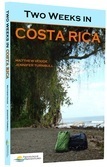
To learn more about Costa Rica, check out our book, Two Weeks in Costa Rica. It's a travelogue with a guidebook twist.
Read reviews and excerpts on Amazon. Post by: Jennifer Turnbull-Houde & Matthew Houde
May 23, 2014
Macaws Flying Free: A Visit to the Ara Project
Since before we moved to Costa Rica, we have been closely following an organization called the Ara Project and their efforts to breed and release endangered Scarlet and Great Green Macaw parrots into the wild. Some of you might remember that we did a fundraiser called Help Save the Macaws when our book was first published in 2012. That campaign was to help build a new facility on the southern Nicoya Peninsula. For a long time we’ve wanted to visit that facility but have never lived close enough to make the trip—until now. This post shares our experience at the amazing Punta Islita breeding center and release site.

We arrived in the small town of Punta Islita after a bumpy hour and a half long ride from Nosara. It was our first drive that far down the Nicoya and we weren’t entirely sure we were going to make it. There was a river crossing but luckily the water was low since it was still early in the rainy season. After crossing the Rio Oro and traversing up and down some steep, jungle-lined hills, we finally arrived. We scoped out the town and visited Museo Islita, a charming Open Air Contemporary Art Museum, then sat down for lunch at a resort restaurant on the beach, one of the only places to eat around. Afterwards, it was time to meet the birds.
We headed up the hill and through a large gate to the Ara Project’s breeding center. Our host, Juan Carlos, an avian specialist and the Project’s site manager, greeted us warmly but didn’t waste any time introducing us to the almost 100 parrots. Dozens of Scarlet Macaws were flying in the surrounding trees and others squawked from large enclosures, which serve as a nursery and school for these colorful birds. While holding Precious, a resident Great Green Macaw, on his arm Juan Carlos taught us about these magnificent birds. Here are some of the many fascinating things we learned about Scarlet and Great Green Macaws.
Macaws live for 70-80 years.
They form bonding pairs when they are young and stay paired for life.
Nests are made in hollow trees and often the Macaws will widen old woodpecker holes to build them.
2-3 eggs are laid but only one chick, the strongest, is kept and nurtured by the parents.
Macaws play an important ecological role in seed dispersal in the jungle.
The range of Macaws in Costa Rica has been drastically diminished by development/deforestation, agriculture, and the illegal pet trade.
Fewer than 1,000 Great Green Macaws are thought to still live in the wild. The range of Great Green Macaws is severely restricted because their primary food source, the mountain almond, is almost non-existent. For this reason, the Ara Project releases Great Greens in Manzanillo on the Caribbean coast, one of the only places in Costa Rica where mountain almond trees remain.

Precious
Now that we knew a little about the birds, Juan Carlos led us higher up the hill to the education center. Here he explained what the breeding center was all about. Most people think that the Project rehabilitates Macaws and releases them back into the wild, but that is not true. Instead, a number of resident pairs are specifically bred in captivity. Since the parents will care for only one of the hatchlings, the Punta Islita team, which consists only of Juan Carlos, two veterinarians, and two volunteers, care for the remaining chicks. This is more than a full time job for the small staff, as the hungry chicks demand food around the clock, hourly at first, and then every few hours. Eventually though the young chicks grow and are taught by the staff which foods to eat on their own. When they are more independent, they are released, eating in the wild around Punta Islita (for Scarlet Macaws) and Manzanillo (for Great Greens). To help the birds adapt, food is supplemented at designated feeders. The other chicks, raised by the breeding pairs, stay in captivity to become the future breeding pairs.

One of the newly built Macaw enclosures
While inside the education center, we also learned what the birds eat and saw samples of the different seeds like Wild Almond, Guanacaste, Naked Indian, and African Palm. We learned that food supplies are limited in the wild due to deforestation and development, and that the staff goes out daily to collect enough food to meet the demand of the ravenous birds.
After our lesson, Juan Carlos then opened the back door and led us outside. His timing was strategic as the staff was about to fill the supplemental feeders. All around us, Scarlet Macaws flew between trees, loudly announcing to one another that the feast was about to begin. They had flown back to the center from the surrounding forest, eager for the daily gathering.

Scarlet Macaws gather on a feeding platform
For us, seeing these magnificent parrots in flight instead of behind the bars of a cage is truly a magical experience. To date, the Ara Project has released around 80 Scarlet Macaws and 32 Great Green Macaws back into the jungles of Costa Rica and there are dozens more waiting in the wings (pun intended). Impressively, there is an 85-90% success rate on releases, and at the Project’s first release site, Scarlet Macaws are now even breeding in the wild. To help keep those birds safe, the organization reaches out to area schools and educates local children in the hopes that they will grow to respect and protect future populations.
How to Visit
We couldn’t have been more impressed with the work done by the dedicated staff at the Ara Project. If you’d like to visit the Punta Islita or Manzanillo release sites, afternoon tours are available with prior notice. A $20 donation is recommended to support the work of the Project. For reservations, email admin@thearaproject.org. Volunteer opportunities are also available for those wanting to lend a helping hand. Visit the Ara Project’s website for more information or email volunteer@thearaproject.org.
While some progress has been made towards increasing the Macaw population, the Project still needs funding to build more enclosures and has a constant demand for supplies. Visit the Project’s website to make a donation or to see what’s on their Wish List.
Post by: Jennifer Turnbull-Houde & Matthew Houde
May 22, 2014
Macaws Flying Free: A Visit to the Ara Project
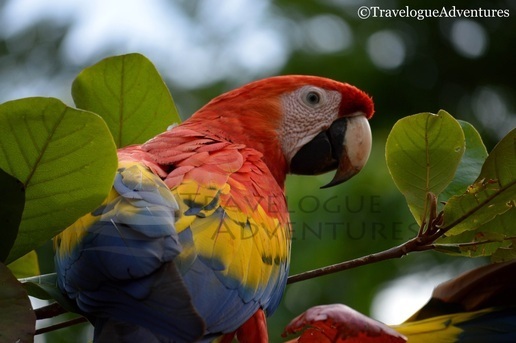
We arrived in the small town of Punta Islita after a bumpy hour and a half long ride from Nosara. It was our first drive that far down the Nicoya and we weren’t entirely sure we were going to make it. There was a river crossing but luckily the water was low since it was still early in the rainy season. After crossing the Rio Oro and traversing up and down some steep, jungle-lined hills, we finally arrived. We scoped out the town and visited Museo Islita, a charming Open Air Contemporary Art Museum, then sat down for lunch at a resort restaurant on the beach, one of the only places to eat around. Afterwards, it was time to meet the birds.
We headed up the hill and through a large gate to the Ara Project’s breeding center. Our host, Juan Carlos, an avian specialist and the Project’s site manager, greeted us warmly but didn’t waste any time introducing us to the almost 100 parrots. Dozens of Scarlet Macaws were flying in the surrounding trees and others squawked from large enclosures, which serve as a nursery and school for these colorful birds. While holding Precious, a resident Great Green Macaw, on his arm Juan Carlos taught us about these magnificent birds. Here are some of the many fascinating things we learned about Scarlet and Great Green Macaws.
Macaws live for 70-80 years.They form bonding pairs when they are young and stay paired for life.
Nests are made in hollow trees and often the Macaws will widen old woodpecker holes to build them.
2-3 eggs are laid but only one chick, the strongest, is kept and nurtured by the parents.
Macaws play an important ecological role in seed dispersal in the jungle.The range of Macaws in Costa Rica has been drastically diminished by development/deforestation, agriculture, and the illegal pet trade. Fewer than 1,000 Great Green Macaws are thought to still live in the wild. The range of Great Green Macaws is severely restricted because their primary food source, the mountain almond, is almost non-existent. For this reason, the Ara Project releases Great Greens in Manzanillo on the Caribbean coast, one of the only places in Costa Rica where mountain almond trees remain.
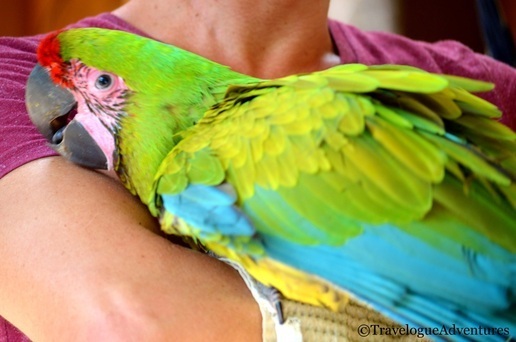 Precious
Precious Now that we knew a little about the birds, Juan Carlos led us higher up the hill to the education center. Here he explained what the breeding center was all about. Most people think that the Project rehabilitates Macaws and releases them back into the wild, but that is not true. Instead, a number of resident pairs are specifically bred in captivity. Since the parents will care for only one of the hatchlings, the Punta Islita team, which consists only of Juan Carlos, two veterinarians, and two volunteers, care for the remaining chicks. This is more than a full time job for the small staff, as the hungry chicks demand food around the clock, hourly at first, and then every few hours. Eventually though the young chicks grow and are taught by the staff which foods to eat on their own. When they are more independent, they are released, eating in the wild around Punta Islita (for Scarlet Macaws) and Manzanillo (for Great Greens). To help the birds adapt, food is supplemented at designated feeders. The other chicks, raised by the breeding pairs, stay in captivity to become the future breeding pairs.
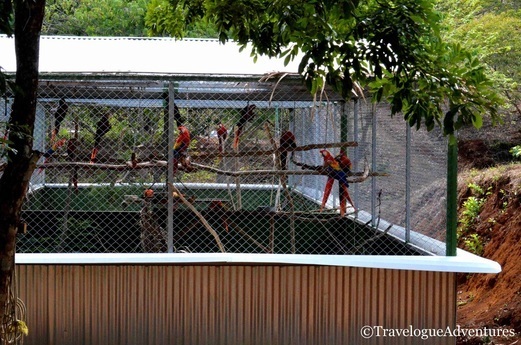 One of the newly built Macaw enclosures
One of the newly built Macaw enclosures While inside the education center, we also learned what the birds eat and saw samples of the different seeds like Wild Almond, Guanacaste, Naked Indian, and African Palm. We learned that food supplies are limited in the wild due to deforestation and development, and that the staff goes out daily to collect enough food to meet the demand of the ravenous birds.
After our lesson, Juan Carlos then opened the back door and led us outside. His timing was strategic as the staff was about to fill the supplemental feeders. All around us, Scarlet Macaws flew between trees, loudly announcing to one another that the feast was about to begin. They had flown back to the center from the surrounding forest, eager for the daily gathering.
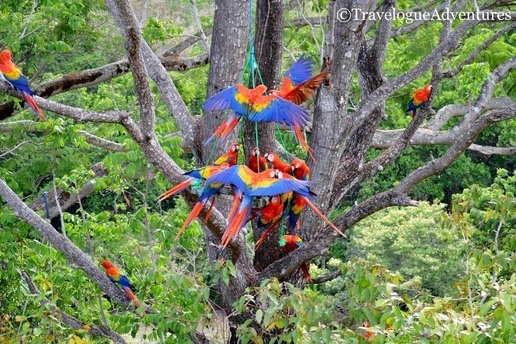 Scarlet Macaws gather on a feeding platform
Scarlet Macaws gather on a feeding platform For us, seeing these magnificent parrots in flight instead of behind the bars of a cage is truly a magical experience. To date, the Ara Project has released around 80 Scarlet Macaws and 32 Great Green Macaws back into the jungles of Costa Rica and there are dozens more waiting in the wings (pun intended). Impressively, there is an 85-90% success rate on releases, and at the Project’s first release site, Scarlet Macaws are now even breeding in the wild. To help keep those birds safe, the organization reaches out to area schools and educates local children in the hopes that they will grow to respect and protect future populations.
How to Visit
We couldn’t have been more impressed with the work done by the dedicated staff at the Ara Project. If you’d like to visit the Punta Islita or Manzanillo release sites, afternoon tours are available with prior notice. A $20 donation is recommended to support the work of the Project. For reservations, email admin@thearaproject.org. Volunteer opportunities are also available for those wanting to lend a helping hand. Visit the Ara Project’s website for more information or email volunteer@thearaproject.org.
While some progress has been made towards increasing the Macaw population, the Project still needs funding to build more enclosures and has a constant demand for supplies. Visit the Project’s website to make a donation or to see what’s on their Wish List.
You Might Also Like:
Bird Photography Tips: How to Get That Perfect Shot
Cabo Blanco Nature Reserve
Diria National Park: Hiking Near Guanacaste's Gold Coast
 Jennifer Turnbull and Matthew Houde first visited Costa Rica about ten years ago. They fell in love with the country’s friendly culture and natural beauty and returned for vacation year after year. In 2012, they published a book about their travels,
Two Weeks in Costa Rica
. Most recently, they took the ultimate plunge and left their careers in the United States for a chance to experience the pura vida lifestyle. They now write full-time from Costa Rica. Follow their adventures on their blog or via Twitter and Facebook. Post by: Jennifer Turnbull-Houde & Matthew Houde
Jennifer Turnbull and Matthew Houde first visited Costa Rica about ten years ago. They fell in love with the country’s friendly culture and natural beauty and returned for vacation year after year. In 2012, they published a book about their travels,
Two Weeks in Costa Rica
. Most recently, they took the ultimate plunge and left their careers in the United States for a chance to experience the pura vida lifestyle. They now write full-time from Costa Rica. Follow their adventures on their blog or via Twitter and Facebook. Post by: Jennifer Turnbull-Houde & Matthew Houde
May 13, 2014
Humidity and Your Camera: Making a Dry Box in the Tropics
 For those just traveling to Costa Rica for a week or two, a few silica packets (like the ones you find in a shoe box) placed in your camera bag and an air conditioned hotel room will probably suffice. But for longer stays, a dry box is the way to go. There are many commercially available dry boxes specifically designed for cameras and other electronics, but you can also easily make one yourself. We got most of the materials for ours from the local Maxi Pali (Walmart-owned store chain).
For those just traveling to Costa Rica for a week or two, a few silica packets (like the ones you find in a shoe box) placed in your camera bag and an air conditioned hotel room will probably suffice. But for longer stays, a dry box is the way to go. There are many commercially available dry boxes specifically designed for cameras and other electronics, but you can also easily make one yourself. We got most of the materials for ours from the local Maxi Pali (Walmart-owned store chain).Here’s what you’ll need:
Plastic container with good sealing lid.
Something to absorb humidity. Silica packets work and can be re-dried at low temps in the oven, but we couldn’t find any in Costa Rica. Instead we used a system of Calcium Chloride (similar to Damp Rid) which is more readily available here.
Humidity gauge. Again, we couldn’t find one here so we bought this one on Amazon and had a friend bring it down for us.
Placemat or something else to keep your equipment from sliding around in the box.
 Completed Camera Dry Box Our dry box setup has been a lifesaver. We keep the humidity level around 40-50%, adding more Calcium Chloride when needed, and store our camera away whenever we aren’t using it. Since our initial fungus discovery five months ago, we haven’t had any problems since. Hopefully this post will help keep your camera and lenses safe too. If you have any other techniques that you use to keep your equipment fungus free, please let us know.
Completed Camera Dry Box Our dry box setup has been a lifesaver. We keep the humidity level around 40-50%, adding more Calcium Chloride when needed, and store our camera away whenever we aren’t using it. Since our initial fungus discovery five months ago, we haven’t had any problems since. Hopefully this post will help keep your camera and lenses safe too. If you have any other techniques that you use to keep your equipment fungus free, please let us know. You might also like:
Bird Photography Tips: How to Get That Perfect Shot
Packing for Your Move to Costa Rica: Advice from Expats
WE’RE MOVING TO COSTA RICA!
 Jennifer Turnbull and Matthew Houde first visited Costa Rica about ten years ago. They fell in love with the country’s friendly culture and natural beauty and returned for vacation year after year. In 2012, they published a book about their travels,
Two Weeks in Costa Rica
. Most recently, they took the ultimate plunge and left their successful jobs in the United States for a chance to experience the pura vida lifestyle. They now write full-time from Costa Rica. Follow their adventures on their blog or via Twitter and Facebook. Post by: Matthew Houde and Jennifer Turnbull-Houde
Jennifer Turnbull and Matthew Houde first visited Costa Rica about ten years ago. They fell in love with the country’s friendly culture and natural beauty and returned for vacation year after year. In 2012, they published a book about their travels,
Two Weeks in Costa Rica
. Most recently, they took the ultimate plunge and left their successful jobs in the United States for a chance to experience the pura vida lifestyle. They now write full-time from Costa Rica. Follow their adventures on their blog or via Twitter and Facebook. Post by: Matthew Houde and Jennifer Turnbull-Houde


